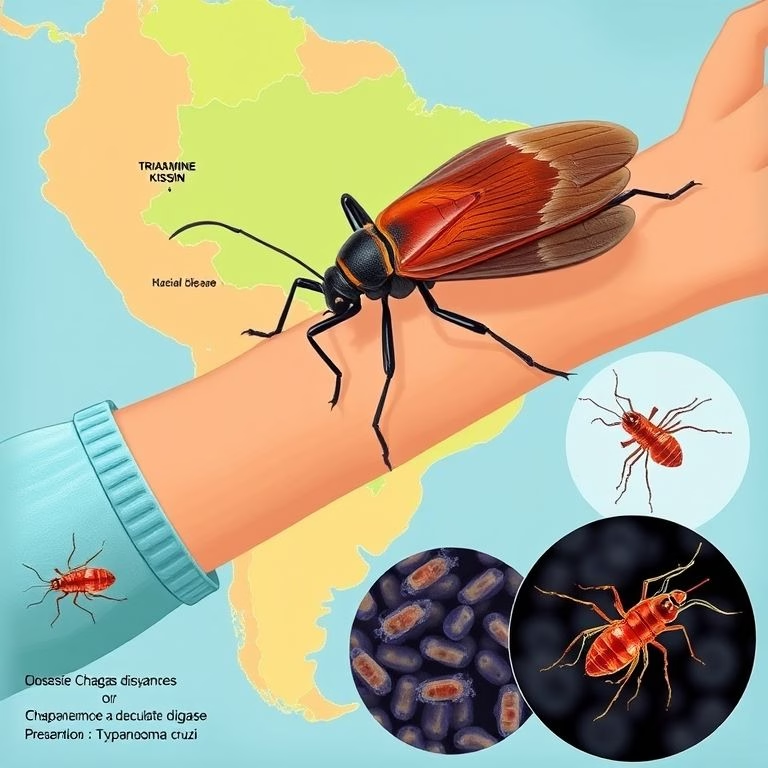Chagas Disease: A Silent Threat in the Americas and Beyond

Chagas Disease: Understanding a Hidden Health Risk
Chagas disease, also known as American trypanosomiasis, is a parasitic illness that often flies under the radar. While less familiar than some tropical diseases, it poses a significant health threat, particularly in certain regions. This blog post will delve into the intricacies of Chagas disease, exploring its causes, symptoms, progression, and the steps being taken to manage and control it.
The Culprit: *Trypanosoma cruzi* and Its Vector
At the heart of Chagas disease lies the parasite Trypanosoma cruzi. This microscopic organism is the primary cause of the illness. However, transmission doesn’t occur directly from person to person, or through the air. Instead, the parasite is primarily spread through the bite of infected triatomine bugs, often called kissing bugs. These nocturnal insects feed on the blood of humans and animals, and if they carry the parasite, their bite can introduce it into the bloodstream. This is the major mechanism for the transmission of the disease.
A Two-Phase Journey: Acute and Chronic Chagas Disease
Chagas disease unfolds in two distinct phases: acute and chronic. The acute phase typically begins shortly after infection. Sadly, this initial phase often goes unnoticed, as many infected individuals experience no symptoms at all. If symptoms do appear, they might resemble a mild flu, including fever, fatigue, body aches, headache, and sometimes, a characteristic swelling at the site of the bite. In some cases, especially in children, the acute phase can be more severe.
The chronic phase of Chagas disease can develop years, even decades, after the initial infection. This phase is where the most serious complications arise. The chronic phase can affect various organs, particularly the heart and digestive system. Potential health issues include:
- Cardiac complications: These are the most common and severe complications. They can lead to heart enlargement, heart failure, irregular heartbeats (arrhythmias), and even sudden cardiac death.
- Digestive problems: Damage to the digestive system can cause the enlargement of the esophagus (megaesophagus) and colon (megacolon), leading to difficulties with swallowing and severe constipation.
- Neurological damage: In some instances, Chagas disease can also lead to nerve damage.
Treatment and Management
Treatment for Chagas disease depends heavily on the stage of the illness. The medications benznidazole and nifurtimox are most effective during the acute phase. These drugs can help to eliminate the parasite from the body and prevent the progression of the disease. However, their effectiveness diminishes in the chronic phase. In the chronic phase, treatment focuses primarily on managing symptoms and preventing further complications. This might involve medications for heart failure, pacemakers for arrhythmias, and surgery for digestive issues.
Geographical Distribution: Where is Chagas Disease a Concern?
While Chagas disease is a global health concern, it’s most prevalent in the Americas. The disease is endemic in Central and South America, where transmission is more frequent due to the presence of the triatomine bugs. However, the geographical distribution is expanding. Cases have also been reported in the southern United States and in other regions, often due to migration from endemic areas.
Efforts to combat Chagas disease involve vector control (eliminating the kissing bugs), screening blood donations to prevent transmission through blood transfusions, and improving the diagnosis and treatment of infected individuals. Public health initiatives are crucial in raising awareness, promoting early detection, and ensuring access to appropriate medical care.
Living with Chagas Disease
Living with Chagas disease, especially in the chronic phase, can present significant challenges. Regular medical checkups and monitoring are essential. Patients should be educated on the potential complications and how to manage them. Support groups and community resources can also play a vital role in helping individuals cope with the emotional and physical burdens of the illness. Early diagnosis and treatment, whenever possible, are key to improving outcomes and enhancing the quality of life for those affected.
If you suspect you may have been exposed to Chagas disease, it is important to consult with a medical professional for testing and appropriate guidance. Knowledge and proactive measures are crucial for mitigating the impact of this silent but serious health threat.




